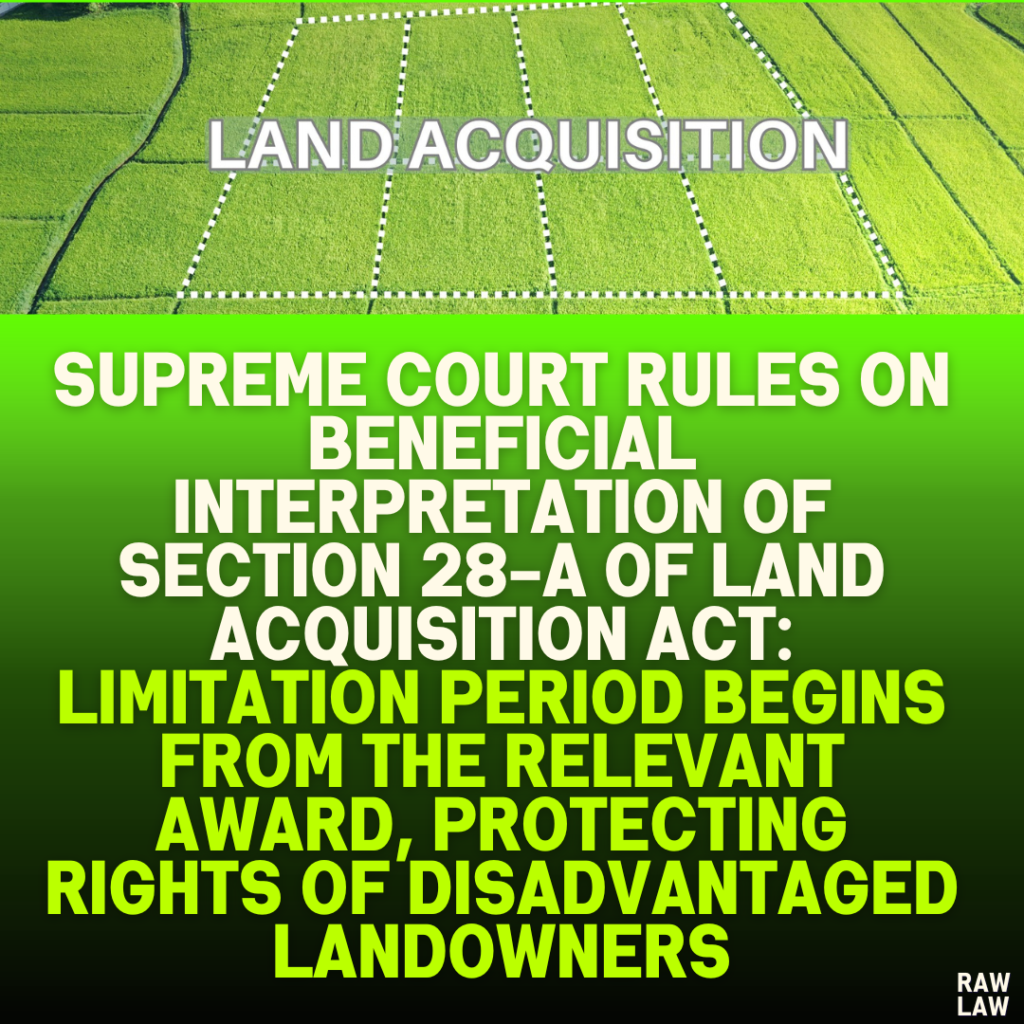Court’s Decision
The Supreme Court overturned the Punjab and Haryana High Court’s ruling that denied the appellants the benefit of enhanced compensation under Section 28-A of the Land Acquisition Act, 1894. The Court upheld the Land Acquisition Collector’s (LAC) decision to grant enhanced compensation, ruling that Section 28-A should be interpreted to align with its purpose of providing equitable relief to poor and inarticulate landowners. The Court emphasized that the limitation period for filing Section 28-A applications starts from the date of the award relied upon by the applicant, not merely the first award under Part III of the Act.
Facts
- Initial Acquisition: The appellants’ land in Jhajjar, Haryana, was acquired in 2004 for the Kundli-Manesar-Palwal Expressway under the Land Acquisition Act, 1894. The compensation was fixed at ₹12,50,000 per acre.
- Enhanced Compensation for Others: Similarly placed landowners, through a reference under Section 18 of the Act, secured an enhanced compensation of ₹19,91,300 per acre through a judgment by the Punjab and Haryana High Court in 2016.
- Appellants’ Claim: The appellants, who had not filed a Section 18 reference earlier, applied under Section 28-A to the LAC, seeking the benefit of the 2016 judgment.
- LAC’s Decision: The LAC allowed the application in 2020, awarding the appellants enhanced compensation.
- Challenge in High Court: The Haryana State Industrial and Infrastructure Development Corporation (HSIIDC) challenged the LAC’s decision. The High Court, relying on a narrow interpretation of Section 28-A from an earlier case, quashed the LAC’s order, ruling that the application was untimely and could not be based on the 2016 judgment.
Issues
- Limitation for Section 28-A Applications: Does the limitation period begin only from the first award under Part III of the Act, or from any award on which the applicant relies?
- Scope of Section 28-A: Should Section 28-A be interpreted narrowly or liberally, considering its remedial nature?
Petitioner’s Arguments
- Beneficial Interpretation of Section 28-A: The appellants argued that Section 28-A is a remedial provision designed to ensure equitable compensation for disadvantaged landowners. Its interpretation should align with this purpose, as clarified in Union of India v. Pradeep Kumari (1995).
- Timely Filing: The appellants submitted that their application under Section 28-A was filed within three months of the 2016 High Court award, fulfilling the statutory requirement.
- Error by the High Court: The High Court erroneously relied on Ramsingbhai Jerambhai (2018), which contradicted the earlier binding precedent set in Pradeep Kumari.
Respondent’s Arguments
- Strict Application of Limitation: The respondents contended that Section 28-A applications must be filed within three months of the first award under Part III, as held in Ramsingbhai Jerambhai.
- Applicability of Awards: The appellants could not rely on an appellate court decision to claim enhanced compensation, as Section 28-A applies only to awards made by the reference court under Part III.
Analysis of the Law
- Legislative Intent of Section 28-A: The provision was enacted to address the inequities faced by landowners who could not file references under Section 18 due to lack of resources or knowledge. It aims to provide such landowners an opportunity to benefit from higher compensation awarded to similarly situated individuals.
- Beneficial Interpretation: The Court emphasized the need to interpret remedial provisions like Section 28-A liberally to extend benefits rather than restrict them.
- Limitation Period: The Court clarified that the three-month limitation under Section 28-A begins from the date of the specific award on which the applicant bases their claim, not solely from the first award under Part III of the Act.
Precedent Analysis
- Union of India v. Pradeep Kumari (1995): The Court had held that Section 28-A applications could be based on any award made under Part III, provided they were filed within three months of the relevant award. The judgment emphasized the provision’s remedial purpose and the need for a liberal interpretation.
- Ramsingbhai Jerambhai (2018): This later judgment narrowly interpreted Section 28-A, restricting its applicability to the first award issued under Part III. However, it did not consider Pradeep Kumari, rendering it less authoritative.
Court’s Reasoning
- Conflict Between Judgments: The Court noted that Ramsingbhai Jerambhai did not address the principles laid down in Pradeep Kumari. It reiterated that under the doctrine of precedent, earlier judgments of equal bench strength take precedence.
- Beneficial Legislation: Section 28-A, being a beneficial provision, must be interpreted in a way that extends its benefits to disadvantaged landowners. Restricting its scope would defeat the legislative intent.
- Timely Application: The appellants had filed their application within three months of the 2016 High Court award. This complied with the requirement under Section 28-A, as clarified in Pradeep Kumari.
Conclusion
The Supreme Court allowed the appeal, quashing the High Court’s decision. It reinstated the LAC’s order granting the appellants enhanced compensation. The Court confirmed that the appellants were entitled to claim benefits under Section 28-A based on the 2016 High Court judgment.
Implications
- Clarification of Law: The judgment provides clarity on the limitation period for Section 28-A applications, ensuring that disadvantaged landowners are not deprived of fair compensation due to procedural technicalities.
- Strengthened Access to Justice: By affirming a liberal interpretation, the Court reinforced the rights of poor and inarticulate landowners to equitable treatment.
- Judicial Discipline: The decision underscores the importance of following binding precedents and resolving conflicts between judgments in favor of earlier authoritative decisions.
- Policy Considerations: The judgment advances the legislative goal of reducing inequality in compensation for land acquisition, particularly for marginalized communities.
This detailed explanation illustrates the judgment’s nuanced approach, its reliance on established precedents, and its broader implications for equitable compensation under the Land Acquisition Act.
